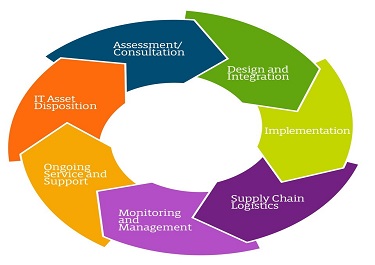 It all starts and ends with the business customer. While that audience has always been a core focus of the channel, many in the industry lost sight of that target, often emphasizing the tech and need for the latest and greatest innovations over the true needs of clients and end users.
It all starts and ends with the business customer. While that audience has always been a core focus of the channel, many in the industry lost sight of that target, often emphasizing the tech and need for the latest and greatest innovations over the true needs of clients and end users.
That’s no longer possible. The business customer is literally in the driver’s seat today when it comes to technology ‒ with department heads and even end-user employees pressing firmly on the gas pedal. Anyone with the ability to follow basic instructions can download, install, and optimize virtually any application online today, disrupting ecosystems formerly ruled by IT teams and third-party providers.
That trend will surely accelerate as Millennials become more empowered in the workforce. That generation has been exposed to and had access to technology from the cradle in the form of interactive educational toys and high-tech baby monitors. Their formative years included the rise of smartphones and social media, and the ability to receive almost instant gratification from online shopping sites like eBay and Amazon. They would like and may now demand more control over the tools they use in the workplace. And many businesses are giving it.
Of course, the Millennials’ entry into the workforce is not the only transformative factor in play. Technological advances are empowering businesses, giving leaders the ability to research and implement their own solutions to save time and money and experiment with new solutions without their IT team’s blessing or support. With few parameters or policies in place, “Rogue IT” is becoming a norm.
What does all that disruption mean for MSPs, VARs, and other channel companies? Challenges for those who can’t or won’t adapt, but opportunity for the tech professionals who have continual and meaningful conversations with their clients ‒not just the owners, but all the managers and as many end users as possible in each department. Those are today’s channel customers.
Keeping Clients “Between the Rails”
With clients’ employees getting more control and technology coming from virtually every direction in today’s business environment, someone needs to help manage it all. The IT team may assume that role in larger organizations, but channel firms can serve as that guiding force in the SMB quite effectively.
In fact, it’s an evolution many MSPs, and solution providers have already made. The role of “Lifecycle Manager” is becoming more predominant, as channel firms begin taking an even more holistic look at the support their clients need in this rapidly changing environment. From procurement and assessment services to security training and end of life e-cycling, and all points in between.
Lifecycle management is more of a services mindset than a portfolio offering. It helps channel companies determine their space in each business client’s universe and deliver and/or manage all the components. Few providers are equipped to deliver every device, service, and application to 100% of their customers.
But that doesn’t mean they shouldn’t manage all those moving parts. For example, an MSP with a strong cloud and remote monitoring practice may need to collaborate with several other tech specialists to meet all the solutions needs of a particular law firm. That may involve working with a mix of channel and direct go-to-market suppliers to support the customer’s security, compliance, and vertical-specific application needs.
Developing a Comprehensive Plan
The value proposition for MSP is managing that “soup to nuts” technology lifecycle for increasing larger businesses. That upstream move is becoming easier for the channel as midsize companies transition to the SaaS/ cloud model and scale back their in-house IT teams who were formerly in charge of monitoring and maintaining all the on-premise servers.
In some of larger organizations making a move to the cloud, the CIO or IT manager takes on more of a security and compliance role, leaving the day to day management to third-party providers. A perfect opportunity for channel companies that understand the “lifecycle.” They determine their strengths and limitations and build alliances with friendly providers who can fill in the gaps.
The ultimate goal? Provide complete business technology support to your clients. And not just the technical aspects such as procurement, implementation, and support; but the things they need to meet regulatory compliance and keep employees from getting into trouble with phishing and other cybersecurity threatening schemes.
That’s also the objective of the CompTIA Technology Lifecycle Services Community. Formerly known as IT Services and Support, members of this newly reimagined group have been hard at work developing an outline of services that channel firms can use to bring it all together for themselves and their customers. One of their latest initiatives identified the seven phases of the technology services lifecycle, an illustration highlighting the most business-critical opportunity areas for channel companies. It is essentially a comprehensive solutions plan for organizations that support the business community.
That chart is a great resource for providers, vendors, distributors, and virtually any tech-related expert. Whether used to identify all the potential needs of their business customers, or to evaluate their own capabilities and limitations, the Phases of the Technology Services Lifecycle should be printed out and posted on the meeting room of virtually every channel business.
Want a copy? Download it here.
That graphic is also a blueprint for the Technology Lifecycle Services Community’s activities. Over the next few months, the group will roll out a number of educational resources to help channel companies improve their success with each phase of the lifecycle, including a podcast series for solution providers.
Has your tech company made the shift? If not, join the conversation and check out the group’s resources to see what you and your customers may be missing.
Brian Sherman is president of Tech Success Communications, a channel-related content and social media development firm. He served previously as the chief editor at Business Solutions magazine and senior director of industry alliances with Autotask. Contact Brian at [email protected]

 Add CompTIA to your favorite RSS reader
Add CompTIA to your favorite RSS reader

